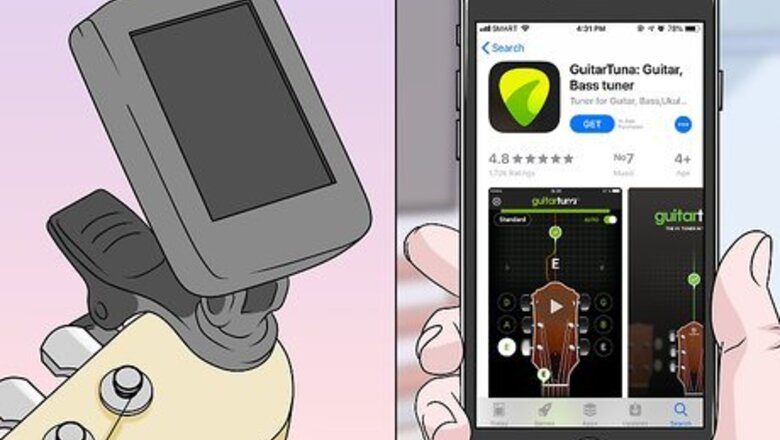
views
Using an Electronic Tuner
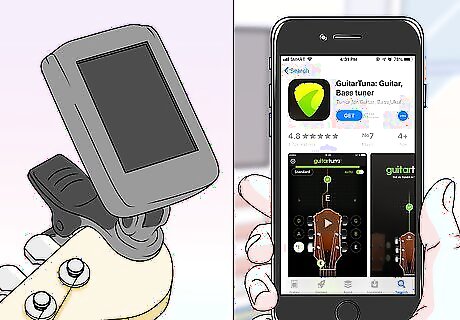
Buy or download an electronic guitar tuner. You can purchase a tuner online or at most guitar stores for under $30. You can also download a guitar tuner app on your smartphone for free. Some tuners can plug directly into your guitar while others just need to be in the guitar’s vicinity as you play. Read reviews for the app or digital tuner you want before downloading or purchasing it. Popular brands for digital guitar tuners include Boss, D'Addario, and TC Electronic. Popular guitar tuner apps include Guitar Tuna, Fender Tune, and Pro Guitar Tuner.
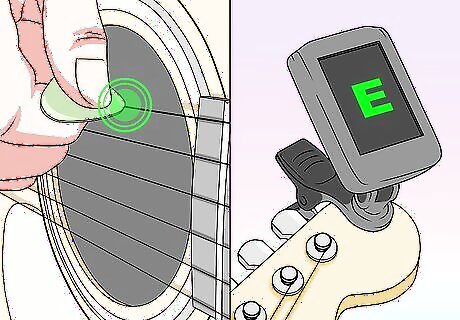
Strum the top string next to the tuner. Turn on the electronic tuner and hold it next to the guitar. Use a pick to strum the top string, or 6th string, and look at the digital display on the tuner to see which note the top string is in. In standard tuning, this string should be an E when played in the open position. The electronic tuner should have a digital display that reads the note you’re playing with a needle under it. When the needle is centered, it means that the note is in tune. If the needle is to the left or right of the center, it means it is out of tune. The open position is when the string is played without holding down any frets on the neck. If you want to tune the guitar to drop D by ear, you need to make sure that the rest of the strings are in tune or you won’t have anything to match the 6th string tone to. If the needle is to the left of the center, it means the note is flat. If it’s to the right, it means the note is sharp.
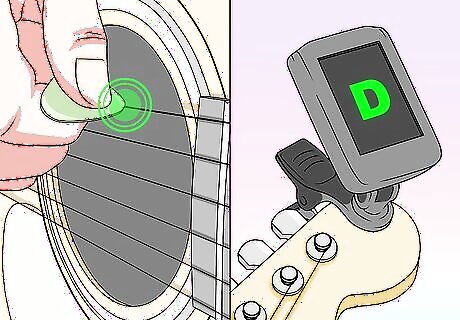
Tune the 6th string to a D note. Play the top string in the open position. It should read an E. Then, turn the knob closest to you on the top of the neck counterclockwise and look at the digital tuner. The needle should move left until the display changes to a D. Keep turning the knob until the needle is in the center and the note reads D. Your guitar's 6th string is now tuned to a D. As you turn the knob, you’ll hear the note of the string change. If the guitar is somewhat in tune, the digital guitar tuner should read an E when you strum the top string.
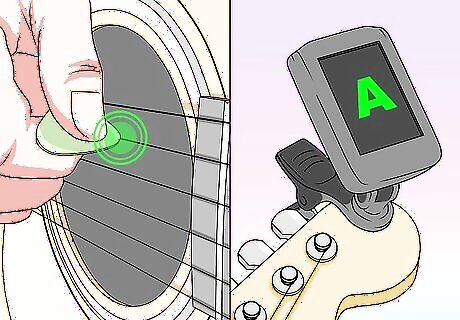
Tune the 5th string to an A. Strum the second to top string, or the 5th string, and read the digital tuner. In standard tuning, this note should be an A. Turn the knob connected to the string until the needle is centered on the tuner.
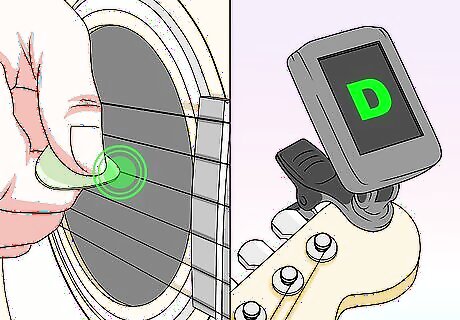
Tune the 4th string to a D. Play the third string from the top, or the 4th string without holding down any frets and see what the note is. Turn the knob until the digital tuner reads a D and the needle is centered on the screen. If the guitar is partially in tune, you’ll only have to rotate the knobs slightly to put it into D. It’s important that the 4th string is properly in tune if you’re going to put your guitar into drop D by ear.
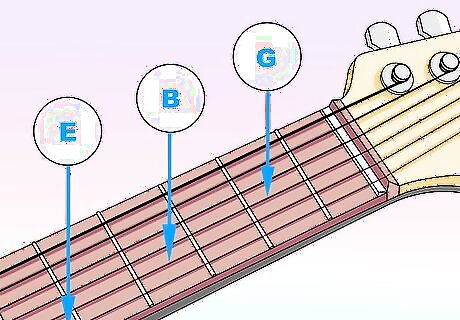
Tune the bottom 3 strings to G, B, and E. Use the same process that you did on the top 3 strings to the bottom 3 strings so that they are in tune. The 3rd string should be a G, the 2nd should be a B, and the bottom string, or 1st string, should be an E. Turn each corresponding knob while strumming the string to ensure that your guitar is completely in tune. Starting from standard tuning will make it easier to tune your guitar to drop D whether you’re using a tuner or tuning to drop D by ear.
Tuning to Drop D by Ear
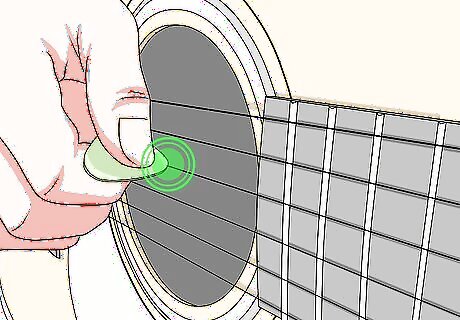
Pluck the 3rd string from the top. Use an electric tuner to make sure your strings are in standard tuning first. The 3rd string from the top on the guitar neck, referred to as the 4th string, is a D note when your guitar is in standard tuning. Strum the string without pressing down on any of the frets on the neck of the guitar to play a D. This is known as playing the string "open." You will match the sound of the top string, or 6th string, with the 4th string. Holding down the frets, or rectangles on the neck of your guitar, will change the note of the string.
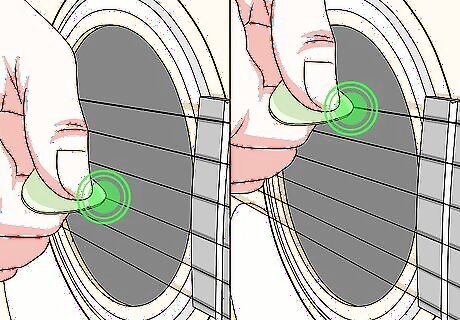
Pluck the top string while the 4th string is still ringing out. Listen to the difference in tone between the top string, or 6th string, and the 4th string as they play simultaneously. This is because in standard tuning, the 6th string is tuned to an E note and the 4th string is tuned to a D note. If the guitar is in standard tuning, playing the two strings at the same time should sound off key. The goal is to lower the note of your 6th string so that it matches the tone of the 4th.
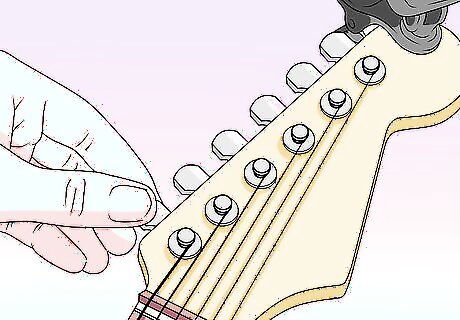
Turn the 6th string knob until it matches the tone of the 4th string. Turn the 6th string knob at the top of the guitar neck counterclockwise to lower it’s tone to a D note. Listen to the vibrations between the two strings and stop turning the knob when they match up. You’ll know they are matching when you don’t hear any warble sounds between the two notes and they both match up. Tuning a guitar by ear takes practice and experience.
Using Harmonics to Tune to Drop D
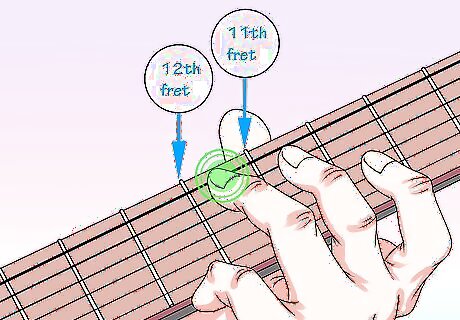
Brush the 12th fret on the top string. Lightly press the metal portion that divides the frets between the 11th and 12th fret of the top, or 6th string. When playing harmonics, brush the string and let go quickly. The frets are the rectangles on the guitar's neck. Usually, you'll hold down the middle of the fret but with harmonics, brush over the metal divider between the frets. Harmonics are the sounds that are created from the vibrations between the strings and the metal on your frets. It may be easier to decipher a harmonic than a full note.
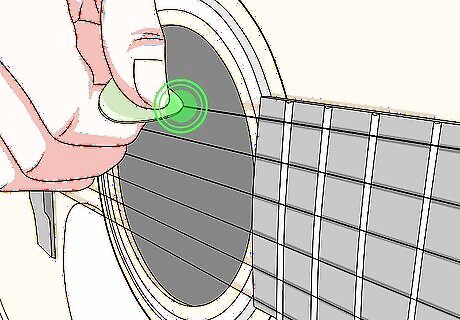
Pluck the 6th string and let the harmonic ring out. Pluck the top string while lightly brushing over the metal divider between the 11th and 12th fret and listen to the metallic ping from your guitar. This is the harmonic. You will match this tone with the D note of the 4th string.
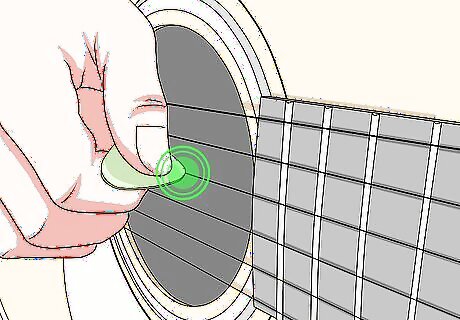
Pluck the open 4th string. Pluck the 4th string without holding down any of the frets, or in the open position, while the harmonic is playing. You should hear that the notes are off key if your guitar is in standard tuning because the top string is tuned to an E while the 4th string is tuned to a D.
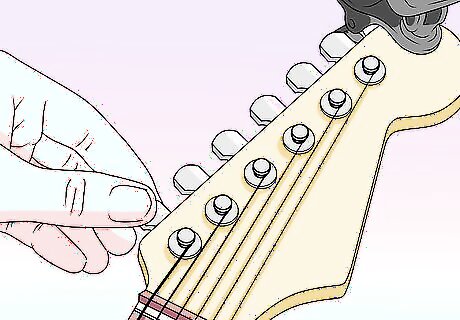
Turn the 6th string knob until the frequencies match. Turn the knob connected to the 6th string until you the frequencies match. When the strings are out of tune, the notes will clash and you'll be able to hear a vacillating sound coming from the guitar. When the sounds of the two frequencies match, your guitar is now in drop D tuning.




















Comments
0 comment